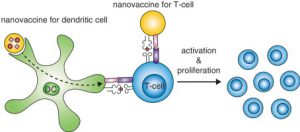In a recent study, Cornell University researchers developed a new class of biomaterials for an infectious disease, nanovaccines, which can effectively improve the immunity of mice with metabolic disorders associated with intestinal bacteria.
This study is the first to explore the relationship between nanomaterials, immune responses and microbial populations, which is an increasingly important research field. “This article focuses on how microbiology affects our engineering vaccines and how we can overcome these problems by developing advanced materials,” said Ankur Singh, an assistant professor at the School of Biomedical Engineering. The article was published in a recent issue of Science Advanced magazine.

More than 1/4 people worldwide suffer from metabolic syndrome, a “protective umbrella” for a variety of diseases, including obesity, inflammation and insulin resistance. Intestinal microbiome is one of the factors leading to metabolic syndrome, and researchers are interested in metabolic syndrome induced by microbiome as that microbiome and metabolic disorders are associated with the immune system.
“In view of public health, it is important to understand how microbial groups affect future engineering vaccines,” said Ilana Brito, assistant professor of biomedical engineering and co-author of the paper. “This study will open up new ways to explore how specific components of the microbiome alter the immune response. In the design of new vaccines, the design of effective materials for a variety of microbial composition is very important. “
Previous studies have shown that traditional human influenza vaccines and poliovirus vaccines fail in mice with metabolic disorders caused by the disruption of intestinal biological communities. “This has prompted us to look at what happens with nanovaccines, which may be better than soluble vaccines to understand the potential role of obesity and inflammation in intestinal changes,” Singh said.
Introduction to Nanovaccines
Nanovaccines, usually composed of nanomaterials, can be ingested by cells in the immune system, and have been found to induce stronger immunity than traditional soluble vaccines in preclinical models. Nanoparticles have the advantages of volume effect, surface effect, small size effect, biological targeting effect, prolonging drug action time and sustained release drug. Using nano-delivery drug carrier as nano-adjuvant, the immune effect of tumor vaccine can be effectively brought into play. As a carrier of tumor polypeptide vaccine, the antigen of polymer nanoparticles (PLGA-NP) adjuvant can be adsorbed on the surface of nanoparticles or encapsulated in them, which can effectively improve the specific immune response of tumor, and also improve the cellular and humoral immune effects of the body.
But the researchers found that the most widely used nanovaccine type made from poly (lactic-co-glycolic acid) (PLGA) was not very effective in mice with intestinal metabolic syndrome. When researchers tested PLGA nanovaccine in mice, it was not as successful as expected, even with the addition of widely used immune enhancers.
“We asked, is there any way to overcome this restrictive reaction by designing new nanomaterials vaccines? Then we studied in depth a new class of materials that regulate the immune system, pyridine functionalized poly (2-hydroxyethyl methacrylate) “new materials to form stable nano-gels with protein antigens, and it was found that it was effective under the condition of intestinal metabolic syndrome.
This study is important because it shows that these nanogels can provide antigens and adjuvants without the need for additional immune enhancers. This may help them to be more immune activated and overcome the limitations imposed by disease or altered microbial groups.
